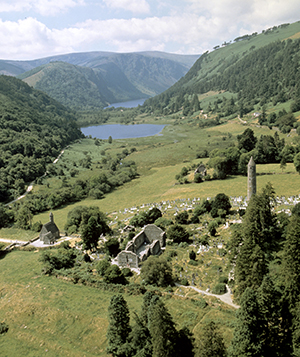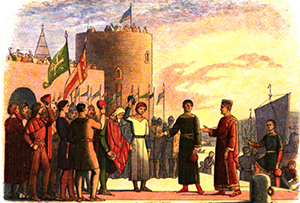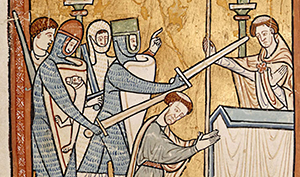The curse of St Laurence O’Toole
Published in Features, Issue 4 (July/August 2018), Medieval History (pre-1500), Volume 26The return of a stolen relic has added another tale to the saint’s legend.
By Jesse Harrington

Above: The metal-encased heart of St Laurence O’Toole, stolen from Christ Church Cathedral in March 2012 and returned in April 2018. But is it cursed?
This April (2018), in the choir-sung presence of the archbishop of Dublin, the Most Revd Dr Michael Jackson, and Garda Assistant Commissioner Pat Leahy, the metal-encased heart of St Laurence O’Toole was returned to Christ Church Cathedral.
The return followed a six-year investigation into the heart’s theft in 2012 and was made possible by a tip-off that located the 800-year-old relic in the Phoenix Park. Intriguingly, several media outlets, including the Irish Examiner, reported that the thieves ‘returned it because they thought it was cursed’ and feared that it ‘was responsible for the deaths of loved ones from apparent heart attacks’.
Whatever the thieves may have believed, Laurence is undoubtedly important as Dublin’s principal patron saint. Along with St Malachy of Armagh, St Oliver Plunkett and St Charles of Mount Argus, he remains one of only four Irish saints to have been formally canonised by the Catholic Church. He was also the last saint of medieval Ireland: after his canonisation, it would be another 400 years, precisely, until the birth of Oliver Plunkett. Most notably, he was a pivotal figure in the great turning point of medieval Irish history—the 1169 Anglo-Norman invasion of Ireland, led by another figure interred in Christ Church, the Earl Richard de Clare (‘Strongbow’). To subsequent generations Laurence became a political and spiritual touchstone imbued with miraculous power. Thus the recovery of his heart (and its reputedly associated curse) represents a distinctly medieval turn to this modern tale.
Life of St Laurence

Above: The monastic city of Glendalough, Co. Wicklow, said to have been protected from brigandage by the curse of Abbot Laurence and his monks during a famine in the 1150s. (Con Brogan)
Laurence’s biography has been pieced together from various contemporary or near-contemporary sources, not least the thirteenth-century Latin Life of St Laurence, prepared at Eu in Normandy for his canonisation.
Laurence (c. 1128–80) was one of four sons of Maurice O’Toole, a king who ruled in what is now part of County Kildare. At an early age he served as hostage for his father with the overking of Leinster, Dermot MacMurrough, before becoming a monk at Glendalough. Glendalough was an important monastic city, tracing its foundation to the sixth-century St Kevin. In 1153 Laurence succeeded as abbot at the earliest possible canonical age of 25. He had a difficult task ahead, having to lead his community through the hardships of famine and brigandage. In 1162 he was consecrated archbishop of Dublin. Dublin was an important city whose trade networks extended throughout the Irish Sea and Atlantic seaboard. Its surrounding kingdom had been fought over by around half a dozen rival Gaelic and Hiberno-Norse dynasties during Laurence’s lifetime alone but was then under Dermot’s overlordship.
Laurence found himself in a complicated position after Dermot’s downfall in 1166. Rory O’Connor, king of Connaught and claimant to the high-kingship of Ireland, had invaded Dermot’s territory and forced the Leinster king into exile. In 1167 Laurence was apparently prepared to acknowledge Rory’s rule. Dermot, however, returned with Anglo-Norman allies, captured Waterford and by 1170 had laid siege to Dublin. Laurence was active in attempting to mediate peace before the city’s capture, and the following year may have supported Rory in raising mercenaries for a counter-offensive. In 1171 King Henry II of England arrived in person to oversee the invasion, and Laurence ultimately witnessed the Treaty of Windsor in 1175. The treaty granted Henry control of Leinster, Meath and part of Munster, while ceding the rest to Rory’s overlordship, provided that he acknowledged Henry as his superior and maintained loyal tribute. The conquest had been consolidated.

Above: King Henry II arriving at Waterford in 1171—Laurence witnessed the subsequent Treaty of Windsor in 1175. (J.W.E. Doyle’s A chronicle of England [1864])
Whatever his views, Laurence’s final years were busy ones. He engaged in church reform and introduced the new Continental order of Arrouaisian canons to Christ Church. In 1179 he was appointed papal legate, convened a synod at Clonfert and arranged the charitable relief of the Irish distressed by the harsh winter. He died of a fever at Eu, Normandy (then under the rule of King Henry as duke of Normandy), on 14 November 1180, having been brought there by drawn-out negotiations over his installation of Rory O’Connor’s nephew, the bishop of Elphin, as archbishop of Armagh.
The curse of Laurence
The theft of Laurence’s relic in 2012 was not the first time that the saint had encountered thieves. The first occasions came in the early years of his abbacy at Glendalough, and were reported in his medieval Life to have ended with no less miraculous effect than the curse alleged of him this year.
The first incident involved a local brigand of noble lineage who murdered laymen, despoiled clerics and defiled women without fear of retribution. When Laurence heard this, the Life tells us, ‘he was struck by great sorrow, and, ascending to the house of God, did not take food’. In solemn prayer and fasting, he petitioned God to mercifully liberate his people. Not long after, the brigand was captured and blinded by a group of men, and died shortly after.
The second incident involved ‘three great princes of thieves’, whose followers ravaged the area and one day set upon a procession of priests and laity carrying consecrated Eucharistic hosts. The men whipped or killed whomever they found and, in further blasphemy, took the hosts and impiously ground them with their teeth. When this was related to Laurence, again he grieved, turned to prayer and fasting from food or drink for an entire day, and brought his clerics into his church to beseech the Lord without ceasing. Once again vengeance fell upon the brigands, when on the eighth day they were captured by servants of the king and hanged within sight of Laurence’s church.
The Life is careful in framing these accounts. It tells that Laurence ‘did not presume divine vengeance in proud temerity’ but only sought in humble prayer the liberation of his people. His faithful watchword was: ‘Yours is vengeance, Lord; You better know the time and the way of retribution’. Thus the writer of the Life was sensitive to the appropriate Christian attitude of mercy and prayer for the salvation of one’s persecutors. Laurence’s actions, however, sat within a more immediate cultural context. Fasting was long established in early Irish law as a formal, regulated ritual—troscad—which allowed laymen or clerics to protest the injustices inflicted by their social superiors and to compel them through social shame into making formal restitution.
Similar practices were well established on the Continent, where the Life was written. In Normandy the Benedictine monasteries had developed from around the ninth century a liturgical ritual known as the clamor, similarly designed to deal with theft or other injustices when no clear mechanism of legal recourse was readily available. The monks would engage in fasting and humble self-abasement on the floor of their church, beseeching God and their patron saint to provide restitution, while inviting the participation of local laity in the public ritual.
While the liturgy besought the transgressor to make amends and to receive forgiveness and reconciliation, it also held out the very clear threat, in biblical language, that those who failed to do so would inevitably be met with the physical and spiritual penalties of divine vengeance. This versatile and multi-layered ritual served both to shame its target and, in a sense, to shame God and the saints themselves into providing justice.
It may be these rituals that Laurence and those who told these stories had had in mind. The Life not only clarifies that Laurence had the right intention (liberation rather than retribution) but also notes, when describing the participation of his clergy, that they were following ‘the manner of a faithful patron’. The matter of right intention and customary precedent were both central to the practice’s legitimacy.
The intercession of Laurence

Above: Detail from a 1225 psalter depicting the martyrdom of Thomas Becket, the archbishop of Canterbury, by knights of King Henry II of England in 1170. Laurence O’Toole’s supporters compared him with Becket. (British Library)
kFor Laurence’s biographer, there was also the more recent precedent of the saint’s English contemporary, Thomas Becket, the martyred archbishop of Canterbury, who had excommunicated his opponents, which contemporaries understood as akin to a formalised curse. Laurence resembled Becket, as the Life saw it, as both had seen attempts on their lives (Laurence was attacked by a madman during a visit to England in 1175) and both had undergone exile in defence of those entrusted to them against an encroaching power. Given that Becket had been canonised within three years of his death, it would have usefully extended the comparison while arguing for Laurence’s sainthood if he had excommunicated or cursed his opponents and persecutors too.
Laurence never excommunicated the Anglo-Norman invaders, but his earlier curse of the thieves of Glendalough offered a suitable alternative. The source of the story was most likely a contemporary, Malachias O’Carroll, bishop of Clogher, who was responsible for a collection of miracles that had reached the canons of Eu who wrote the Life. Malachias had his own complex relationship with the new conquerors but was not afraid to condemn them for perceived injustice. For example, he publicly admonished with a threat of heavenly sanction one Anglo-Norman adventurer whom the clergy of Armagh had formally cursed for stealing a cooking pot during a raid on that city.
The canons of Eu who received these stories lived in a region that was severed from English rule when the king of France took Normandy in 1204. They might therefore have openly sympathised with the Irish and the cause of their newfound patron when writing his Life in the 1220s. Laurence’s alleged final words were for his people in Ireland: ‘Alas, you poor, foolish people, what will you do now? Who will take care of you in your trouble? Who will help you?’ A list of posthumous miracles included at the end of the Life implicitly answered the question, by reminding readers that the saint’s power could continue after death. The retelling of Laurence’s miracles at Glendalough meanwhile served a more specific reminder of the divine punishment that befalls those who take what is not theirs and, perhaps more importantly, those who oppress and persecute a people who can still cry to God for justice.
The theft of Laurence’s heart

Above: Mosaic of St Laurence O’Toole in the Catholic St Patrick’s Cathedral, Armagh.
With the importance of relics came the possibility of theft. Arguably the most famous incident involved the theft of the relics of St Nicholas from Myra in 1087. That year a group of Italian merchants from Bari decided to seize the relics for their city, against the wishes of the community who guarded them. When the winds dropped during the return voyage, it was taken as a sign of the saint’s displeasure that a crewman had taken a finger of the saint for himself. The winds resumed when the finger was returned to Nicholas’s body. This in turn was taken to signal that he willed for his body to be brought to Bari, provided that it was brought intact. The event was considered a celebrated instance of sacra furta or ‘pious theft’—a concept that hinged on the idea that even in death a saint was sufficiently powerful to protect himself, and that the success of the theft itself signified the saint’s favour for the endeavour. Other saints who did not wish their bones to be disturbed were remembered as taking stern, even lethal, measures against those who upset their wishes.
Until 2012, Laurence’s relics followed a far less contentious path. His body was buried at the Church of the Virgin Mary in Eu, where he had died. His heart was preserved in a reliquary at Christ Church Cathedral from around the time of his canonisation. His skull was brought to England in 1442 and interred at the parish church of Chorley, rededicated in his honour, until it disappeared during the Reformation. Until 2012 the only miracles associated with Laurence after his death—at least of those preserved in his Latin Life—were miracles of healing or even of raising the dead. The allegedly fatal curse on the family of the thieves of 2012 is a new addition to that tradition. But it is a tale that, following the reported events of the 1150s at Glendalough, might be nonetheless after his own heart.
Jesse Harrington has recently completed a doctorate at the University of Cambridge on the representation of divine vengeance and saints’ curses in England and Ireland, 1060–1215.
FURTHER READING
M.T. Flanagan, ‘Laurence [St Laurence, Lorcán Ua Tuathail, Laurence O’Toole] (c. 1128–1180)’, Oxford Dictionary of National Biography, vol. 32 (Oxford, 2004), 691–3.
D. Forristal, The man in the middle: St Laurence O’Toole, patron saint of Dublin (Dublin, 1988).
L. Little, Benedictine maledictions: liturgical cursing in Romanesque France (London, 1993).
D. Ó Corráin, The Irish Church, its reform, and the English invasion (Dublin, 2017).
















